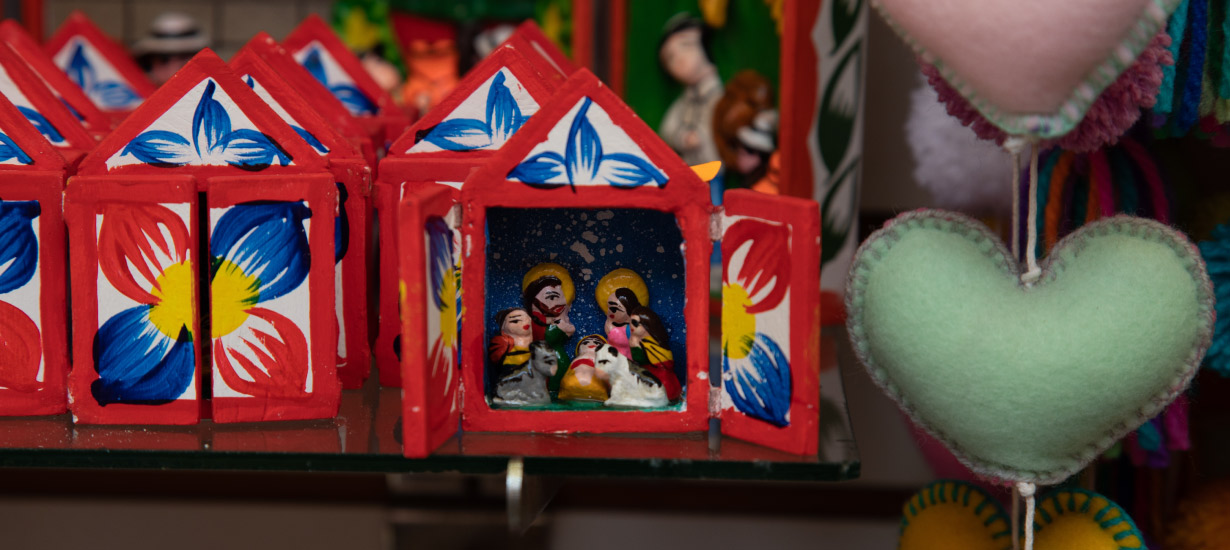Christmas retables: Rediscovering Peru’s ancestral Christmas tradition
Síguenos en:Google News
The retables, especially those made for Christmas, hold a little piece of Peru in every one of their tiny details.
Christmas retables in Peru are among the country’s most iconic and vibrant cultural expressions. This traditional art, known for its intricate scenes and vivid colors, offers a uniquely Peruvian take on the nativity, celebrating the birth of Jesus through local artistry.
Rooted in Andean culture and blending Christian iconography with folk art, Christmas retables are a testament to the remarkable creativity of Peruvian artisans. So, let’s begin this colorful and imaginative journey through the spirit of a Peruvian Christmas!
 Source: Shutterstock
Source: Shutterstock
Origin and history of retables
Ayacucho is the heart of Peruvian handicrafts, and it is here that the enchanting tradition of the retable originated. According to the book "El retablo ayacuchano. Un arte en los Andes" (The Ayacucho retable: An art in the Andes), the craft of creating retables began in the Andes under the name Cajón de San Marcos (St. Mark's drawer).
Retables began to gain recognition in Lima in the mid-1940s, first appearing in private collections, then in exhibitions, and eventually in craft markets.
Going back to its origins, the retable dates to colonial times, when Spanish priests introduced it to depict religious scenes as a tool for evangelizing the people of the Andes. Over time, Andean communities embraced this art form, adapting it to reflect their own worldview and traditions.
 Source: Alex Bryce / PROMPERÚ
Source: Alex Bryce / PROMPERÚ
Rather than limiting themselves to traditional religious themes, Peruvian artists began incorporating elements of Andean daily life and nature, creating works that blended Christian faith with their own cultural beliefs and practices. These retables depict bullfights, festivals, cockfights, traditional dances, rural scenes, saints, virgins, Holy Week processions, and more.
Thus, what began as Cajones de San Marcos evolved into the art form now known more broadly as Retables. However, the wooden boxes retained their characteristic polychrome floral decoration, preserving a key element of their original design.
 Source: Shutterstock
Source: Shutterstock
Features
A Peruvian Christmas retable typically features a wooden structure with doors that open to reveal a miniature scene inside. The interior is adorned with hand-painted clay or plaster figures, depicting nativity characters such as the Virgin Mary, St. Joseph, baby Jesus, the three wise men, and shepherds, along with animals and other elements unique to the Peruvian rural landscape.
The figures are typically painted in vibrant colors like red, yellow, and blue, adding both energy and symbolism to the retable. Every detail is meticulously crafted and painted, showcasing the artisans’ skill. Often, local touches are added, such as regional clothing like ojotas (sandals) and chullos (traditional hats), as well as native animals and plants, giving each retable a distinctly Peruvian identity.
Meaning and symbolism
Christmas retables in Peru embody a blend of faith and Andean culture. They offer a unique way of celebrating Christmas, not only focusing on the birth of Jesus but also incorporating significant elements of the surrounding environment.
For many Peruvian families, both at home and abroad, having a Christmas retable is a way to preserve and honor their cultural heritage. The creation of retables has also become an important source of economic support, while helping to ensure the continuation of this deeply rooted tradition.
 Source: Shutterstock
Source: Shutterstock
The universal legacy of Joaquin Lopez Antay
A key figure in the revaluation of traditional art, Joaquin Lopez Antay (1897-1981) was a renowned artist, celebrated for his mastery in creating Ayacucho retables. Around 1940, his work introduced a new technique to what was still referred to as the Cajones de San Marcos.
This pioneering artist created a mixture of gypsum and potato to produce a malleable material that was both durable and lightweight, making it easier to transport. In doing so, he helped solidify the tradition of Ayacucho retables in the form we know today.
His impact was so significant that in the 1970s, he was awarded Peru's most prestigious honor in his field: the National Culture Award. This recognition marked a milestone in the acknowledgment of popular art in the country.
How to get a retable in Lima?
Obtaining a retablo in Lima is relatively simple, as there are several places where you can find these beautiful objects. Some options include:
Indian Market - Centro Artesanal Miraflores: Located on Avenida Petit Thouars, this market offers a wide selection of Peruvian handicrafts, including retables.
Ruraq Maki Fair: If you visit Lima in July or December, the Ruraq Maki Fair, organized by the Ministry of Culture, is an excellent option. This event brings together the finest artisans from all over Peru.
Workshops in Ayacucho: If you have the opportunity to travel, visiting Ayacucho itself is an excellent option. This region is the birthplace of the retables.
In this way, Peruvian Christmas retables embody an ancestral tradition that blends art, faith, and culture, while also showcasing the creativity and skill of Peruvian artisans.
There is no doubt that each retable tells a story, not only of Christmas but also of the life and beliefs of the Andean communities. As this tradition continues to spread beyond Peru's borders, Christmas retablos have become a powerful symbol of Peruvian spirit and identity around the world.








